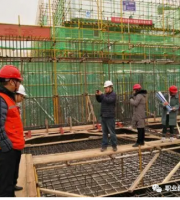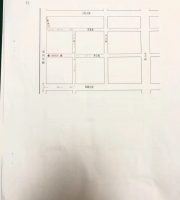In the process of concrete construction, the upper surface of the newly poured concrete can not be covered by the formwork and exposed in the atmosphere
. 
Due to various reasons, cracks often appear on the surface before the beginning of maintenance
.
Especially in summer construction, the cracks of concrete with large horizontal surface are more prominent, such as cement concrete pavement, cement concrete bridge deck and bridge deck pavement in summer construction, there are different degrees of cracks before curing
.
In view of this phenomenon, according to the characteristics of this kind of concrete construction in summer, this paper puts forward some simple and easy prevention measures for early cracks in summer construction
.
1
.
The main characteristics of concrete construction in summer with large horizontal surface 1
.
1
.
The climate is hot and the temperature is high 1
.
2
.
The temperature of the concrete materials is high
.
Due to the high temperature and sunlight, the temperature of the sand and stone materials used to form the concrete mixture is high; The temperature of newly manufactured cement is often high
.
Due to the hot climate, the heat in the cement is not easy to dissipate, and the influence of solar radiation and other factors, the temperature of cement is high, and the temperature of some cement can be as high as 70 ℃
.
1.3 the temperature of supports such as concrete foundation or formwork is higher than 1.4, the exposed surface is larger, and it is greatly affected by the environment The main causes of cracks on the surface of concrete 2.1 the large evaporation rate of surface water causes the water loss on the surface of fresh concrete, forming plastic and shrinkage cracks
.
The water loss on the surface of concrete is mainly caused by plastic shrinkage
.
When the evaporation rate of concrete surface is 1kg / m2 / h, plastic shrinkage cracks are easy to appear on the surface
.
Air temperature, temperature of concrete mixture, relative humidity of air and wind speed are the main factors that affect water evaporation on concrete surface
.
The higher the temperature of concrete itself, the smaller the relative humidity of air, the greater the wind speed, the greater the evaporation rate of water on the surface of concrete
.
Due to the higher temperature in summer, the hydration heat of cement in concrete is generated in a short time, which promotes the temperature of early concrete
.
Relevant data show that when the air temperature is 14 ~ C, 43% of the total hydration heat is produced in the first 24 hours after concrete mixing; When the air temperature is 30 ℃, 62.5% of the total hydration heat is produced in the first 24 hours after mixing
.
On the one hand, the high temperature of coarse and fine aggregates and cement itself increases the temperature of early concrete, on the other hand, it makes the heat of cement hydration more concentrated, and the high temperature of the environment makes it difficult for the heat in concrete to radiate, so the overall temperature of concrete is much higher than that of concrete in other seasons
.
Under the influence of the summer dry wind, the high temperature concrete increases the evaporation rate of water on the surface, which makes the surface lose water rapidly and produce serious plastic shrinkage, and the high temperature inside promotes the rapid progress of cement hydration and concrete hardening
.
Under the joint action of severe plastic shrinkage on the surface and internal restraint, the plastic shrinkage cracks on the concrete surface are produced
.
Water evaporation not only causes surface cracks, but also causes insufficient hydration water of concrete surface due to water loss, which affects the hardening and strength growth of surface concrete
.
2.2 the temperature difference of concrete section causes thermal cracks on the surface
.
During the construction of concrete in summer, the temperature of the foundation or formwork is higher than the ambient temperature due to the sun exposure
.
Its height makes the speed of cement hydration and the speed of hydration heat in the concrete adjacent to it greater than that of the surface, resulting in the increase of temperature difference between the surface and the internal concrete
.
When the difference between the surface temperature and the internal temperature exceeds 15 ℃, it is easy to produce surface thermal cracks
.
Under the influence of high temperature concrete, the foundation or formwork is easy to produce expansion deformation, while the thickness of large surface concrete is generally small
.
The expansion deformation of the lower part has a reverse constraint on the shrinkage of the surface concrete, which increases its tensile stress and has a negative impact on the surface cracks
.
2.3 the influence of high temperature on the microstructure of concrete is generally considered to be negligible when the temperature of concrete is below 50 ℃
.
When the temperature of concrete is above 70 ℃, the influence of high temperature on mass concrete is often ignored Due to the influence of material temperature, template or foundation temperature and concentrated release of cement hydration heat, the temperature rise will often make the temperature exceed the unfavorable maximum temperature
.
Due to the small deformation resistance of early age concrete, the change of concrete microstructure not only affects the overall strength of concrete, but also easily forms thermal cracks on the surface
.
2.4 the changeable climate makes the concrete surface vulnerable to cold attack
.
Due to the changeable construction climate in summer, such as sudden rainfall, the temperature will drop suddenly
.
The sudden drop of concrete surface temperature will cause surface temperature shrinkage and produce surface temperature shrinkage cracks
.
2.5 the increase of cement consumption and water cement ratio in construction increases the plastic shrinkage deformation of concrete
.
In summer construction, due to evaporation and other factors in the process of mixing and transportation, it is easy to cause water loss of concrete mixture and reduce its workability
.
Therefore, it is easy to increase the amount of cement and water cement ratio in construction to improve the workability of concrete, and the increase of the amount of cement and water cement ratio is more likely to cause shrinkage, when the shrinkage is constrained, it is easy to form cracks
.
2.6 when the hardened concrete is constructed under high temperature, the solid forming temperature determines the base length of the concrete
.
When the concrete is cooled as a whole, it begins to contract from this length and temperature, which is very easy to produce the overall temperature shrinkage cracks, such as the broken pavement
.
three Prevention measures 3.1 select the appropriate curing method, start curing as soon as possible, start curing as soon as possible and keep the concrete surface moist, which can prevent evaporation, reduce shrinkage and ensure the smooth progress of concrete surface hydration
.
For the newly poured concrete with various curing methods, the curing should be started after the surface shaping and before the surface water film disappears
.
However, the formed surface of the concrete should not be polluted or damaged during the curing
.
Therefore, the appropriate curing method and the best curing start time must be selected
.
3.2 increase air relative humidity Increasing the relative humidity of air can effectively reduce the evaporation rate of water on the surface of concrete
.
Spraying water mist in the upwind direction or around the fresh concrete to increase the relative humidity of air is a simple and effective measure with low cost
.
The simple spray method can be built around the new concrete site or upward wind direction by using plastic hoses with pinholes, and by injecting water with a certain pressure to form a pinhole spray
.
3.3 reducing the temperature of concrete can effectively reduce the plastic shrinkage caused by the evaporation of water on the surface of concrete and prevent the generation of thermal cracks
.
At the same time, it can reduce the temperature of hardened concrete and reduce the possibility of shrinkage cracks caused by temperature shrinkage
.
The following methods can be used to reduce the temperature: A
.
to protect the fresh concrete from direct sunlight by covering it with a shed, so as to reduce the environmental temperature of the concrete surface; b
.
The temperature of new concrete mixture should be controlled below 32 ℃; 3.4 construction at night or in the morning, the temperature at night and in the morning is low, the temperature of the foundation or formwork is also low, so it can effectively reduce the concrete temperature and the evaporation rate of water on the concrete surface
.
A public official account of the floor of the circle with millions of connections: sh_ Kingcom} long press the QR code to “recognize” attention.
.



